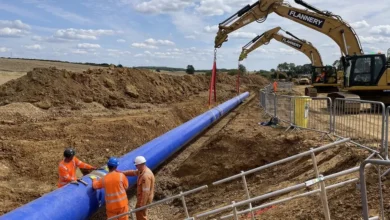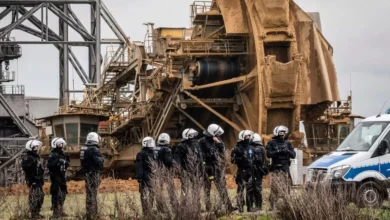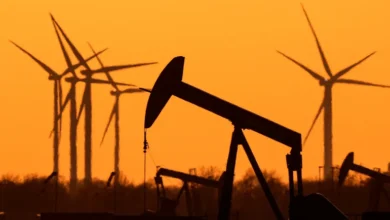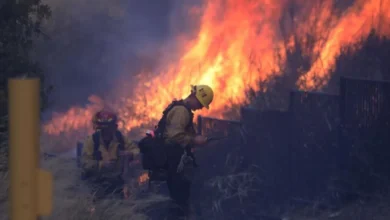‘This is going to be much bigger than we thought’: The Maldives’ dramatic underwater meeting
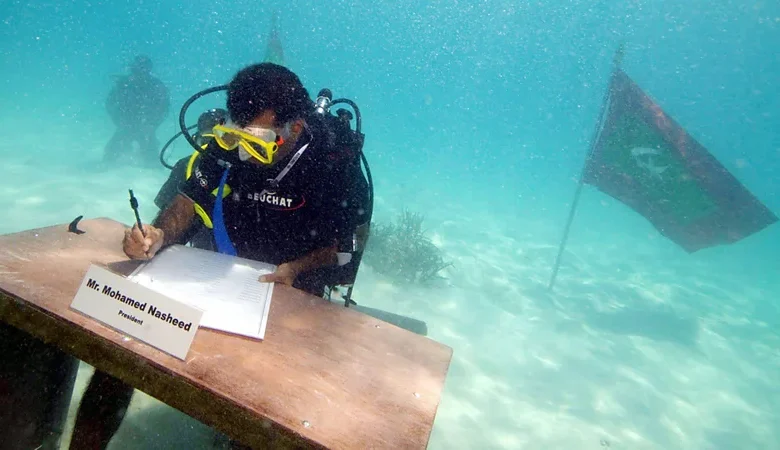
The photo shaped the world’s perception of the existential threat climate change poses to low-lying island nations.
It was a plan that made Shauna Aminath and her team extremely nervous. Aminath, who has formerly served as a Maldivian politician, was planning an underwater photoshoot in October 2009. They were to sink a enough tables and chairs for 11 of the Maldives’ top government officials, to the seabed for a cabinet meeting that would be photographed, filmed and broadcast across the world. Most of the ministers did not know how to dive, some had health problems and none were spring chickens.
If that wasn’t stressful enough, the government had put out a press release announcing the stunt and, immediately, the phone began to ring. Many major international newspapers and TV channels wanted to cover the event. “And I think that’s when we started to feel, ‘Oh, this is going to be much bigger than we thought,'” recalls Aminath, who at the time held the position of deputy undersecretary for policy of the Maldives’ President’s Office.
The team’s nerves were understandable. They were about to carry out a stunt that would become famous, and launch the Maldives and other small island nations to the forefront of global debate on climate change. The repercussions of the photos taken would reach far further than Aminath had hoped. Some credit it with helping to shape the world’s ambitious climate target. But the image and its legacy are not without controversy.
Why the Maldives wanted faster action
When Aminath speaks to me, 16 years after the photoshoot, the Indian Ocean is visible just outside her office window, indigo denim in colour, white waves fraying against the harbour wall. The fear of what rising seas, driven by climate change, will do to her country was the catalyst behind the image.
As the atmosphere warms, the oceans absorb the heat and expand; glaciers and ice caps melt too. Both cause global sea levels to rise, which is a major problem globally, but especially to the Maldives; it’s the lowest-lying nation in the world. The UN body that assesses climate change, the Intergovernmental Panel on Climate Change, predicts the global waters could rise by an average of about half a metre (50cm/1.6ft) by the end of the century – an existential threat to a country that’s mostly a mere metre (3.3ft) above sea-level.
“Most people think that [the Maldives are] a beautiful honeymoon destination. And I think the majority of the world don’t connect with the climate risks and how vulnerable we are,” Aminath says.
“We have families here, we have our entire life laid out here,” she adds. “And if our islands are going to get flooded regularly, if our fish stocks are going to be affected, if our tourism industry is going to be affected, that means life in the Maldives is going to become so complex that we might not be able to continue to maintain the standard of living that we even have now.”
Back in 2009, limiting warming to 2C since pre-industrial times was the internationally agreed climate target. But shifting the dial down by even half a degree to 1.5C meant 10cm (4in) less sea-level rise by 2100 as well as 10 million fewer people exposed to flooding.
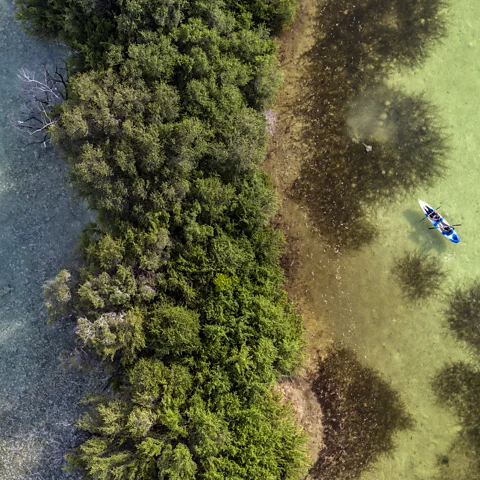
A rallying cry from low lying islands around the world, including the Maldives, was beginning to gain momentum: “1.5 to stay alive”. But for many, a number like that is an abstract concept and carries no real meaning. The photoshoot aimed to bring home what a warmer world might mean for The Maldives.
But first, the government advisors needed to be taught to dive.
The making of a famous photograph
The ministers were extremely difficult to pin down – travelling on business or sometimes sick, Aminath tells me. Eventually, after two months or so, all ministers were equipped with the knowledge to dive and crucially, experienced enough not to kick up sand on the seabed floor, which would obscure the visibility and ruin the photo.
As a result, it was decided no journalists could enter the water either, to ensure a clear shot. The day arrived: 17 October 2009. And hovering nervously above the waves, watching and waiting, was Aminath and a crowd of journalists.
“I remember one of the very senior journalists from a big TV channel – without even telling us – just jumped into [the water]. And all the other press were very upset because they thought that we had allowed the journalist to jump into the water.” Aminath says they had to haul him out. “And of course it was very chaotic, very hectic,” she adds.
Meanwhile, below the waves, ministers had taken their sub-surface seats in front of nameplates, armed with special underwater pencils. Coral was the centrepiece and stripey black-and-white fish darted between the bubbles blown by the divers. The ministers communicated with hand signals and notes written on white boards, and ended by signing a document calling on all countries to slash carbon dioxide emissions.
“What we are trying to make people realise is that the Maldives is a frontline state. This is not merely an issue for the Maldives but for the world. If we can’t save the Maldives today, you can’t save the rest of the world tomorrow,” said Mohamed Nasheed, Maldivian President at the time, once he resurfaced.
The photo’s complex legacy
Photographs of the stunt were splashed across newspapers across the world and the filmed footage made the rounds on major TV outlets. It inspired other leaders to perform similar stunts to highlight the climate emergency – like the prime minister of Nepal holding his cabinet meeting on Mount Everest later that year or Tuvalu’s foreign minister standing knee-deep in the sea whilst giving a speech in 2021.
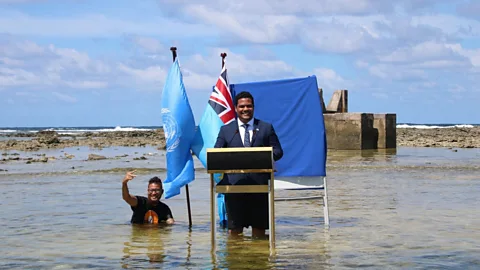 Tuvalu Ministry of Justice, Communication and Foreign Affairs
Tuvalu Ministry of Justice, Communication and Foreign Affairs“It’s a powerful, impactful image,” says Benoit Mayer, professor of climate law at the University of Reading in the UK. The challenge with climate change is it’s an abstract, diffuse and slow-moving disaster and as a result, it’s hard to relate to, he says. Previously, it had been depicted with polar bears stranded on ice floats. But this image was among the first to “put a face on climate change”, Mayer says, making the issue about people, not polar bears.
“It’s one of the key pictures that we know about that really represents the impact of climate change on small island developing states and their populations,” Mayer adds.
But Mayer is concerned that the image presented the Maldives as the main victim of climate change, when they had just built a new airport terminal that could double the number of passengers travelling to the country to seven million a year. Flying has caused 4% of global warming to date. The Maldives government press office was contacted on this point but did not respond by the time of publication.
The continued push for 1.5C
The image was important in another way, says professor Joeri Rogelj, director of research at the Grantham Institute and Professor of Climate Science at Imperial College, London. It put the 1.5C target “front and centre”, he says.
Two years after the photo, at the world’s annual climate summit in Cancun, COP16, it was agreed the impacts of 2C target v 1.5C would be reviewed by scientists. Rogelj was one of those scientists tasked with finding out. The findings from the 2013-15 review were stark. “2C is not a safe limit. It cannot be considered a guardrail,” say Rogelj, summarising the report. “It should be considered a defence line from which you want to stay as far away as possible.”
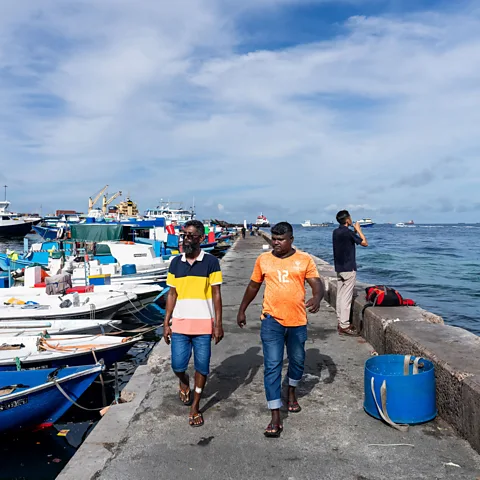
With the science behind the 1.5C target, the campaign only became stronger and in 2015, the new, lower target was formally recognised at COP21 in Paris. It’s by far the most ambitious climate target the world has ever seen.
But today, 10 years after that landmark agreement, we are hurtling to a world that is 1.5C warmer than pre-industrial times, with no signs of slowing down. Current policies put us on a path for 2.8C of warming by 2100. The year 2024 was the first to breach the 1.5C threshold over a calendar year – though the 1.5C limit will only truly be breached when a global decades-long average passes 1.5C of warming.
Despite the projections, Rogelj doesn’t think 1.5C is dead in the water, though others have said that an at least temporary overshoot is inevitable. “The fact that we are failing to limit warming to 1.5C doesn’t remove the 1.5C target,” he says. “The pursuit of that target becomes different because, not only do we need to reduce our emissions as quickly as possible, we also will have to remove carbon dioxide from the atmosphere.”
The 2009 underwater cabinet image had a lasting impact on perceptions of climate change, but a lot has changed in the past 16 years. I ask Aminath what photo she might take now.
“I’ve been in rooms where ministers have shown pictures of their grandchildren and that’s very real,” she says. “It’s a very emotional thing to think about. What will happen to my daughter when she’s my age?
“If our children don’t have a home, where are they going to go? I think that’s the photo that I want to take.”

